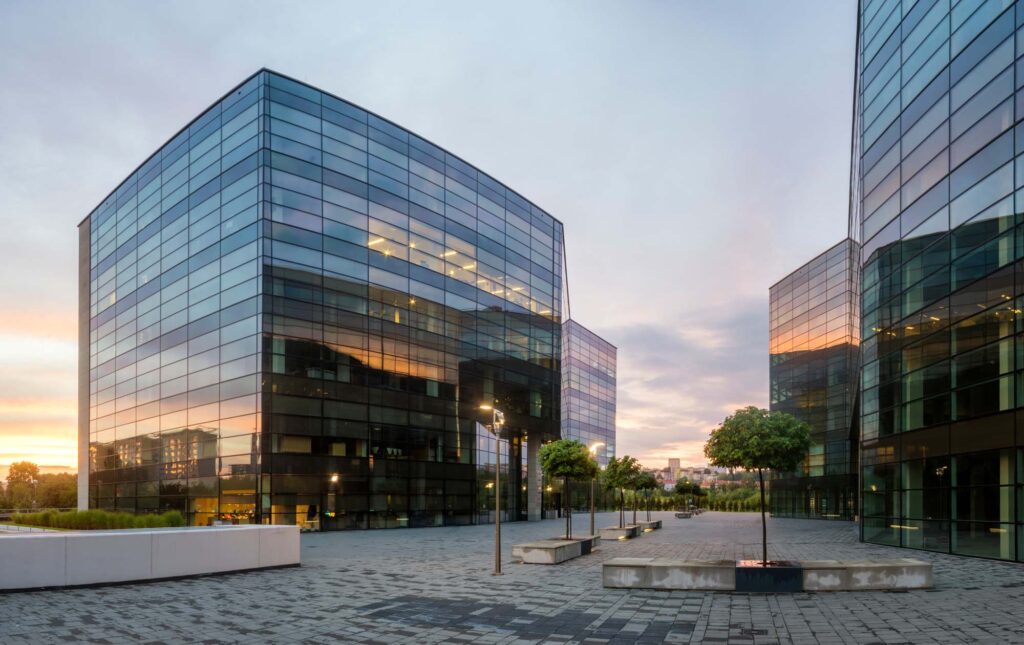Uncertain. That was the most appropriate description of the sentiment in the office market in the wake of the Covid-19 pandemic.
After white collar workers were forced to get used to working from home, some commentators speculated that the office as we knew it in 2019 was dead. Others predicted a return to normal in a matter of years if not months after the final lockdown. The truth was that nobody really knew.
Coupled with a volatile economic picture, the situation led to a certain degree of inertia, with many companies choosing to wait and see before making property decisions – and investors waiting to see where capital values landed.
However, it appears that the kaleidoscope is starting to settle once again, and with it, the office market.
Promising signs for the year ahead and beyond
The results of Rightmove’s latest Commercial Insights Tracker, covering the last quarter of 2024, are certainly promising. It found that demand for office space was up 11% year on year and that supply increased by 2%, suggesting an imbalance that should drive rental growth. On the investment side, meanwhile, demand was up by 57% compared to 1% on the supply side.

Rightmove’s research dovetails neatly with forecasts from some of the biggest agents and consultants in the UK. CBRE, for example, writes that most companies that wanted to downsize as a result of changed working patterns have already done so and that many organisations are now looking to expand.
“Some occupiers are continuing to evolve their hybrid working strategies, with an element of ongoing space right-sizing,” it says. “While some occupiers have downsized over the past three years, the number of central London occupiers moving into larger premises has been twice as high as the number of occupiers moving into smaller premises. On top of this, since the last lockdown in the UK, a third of take-up has been from new entrants to the central London market.”
It adds: “We feel the market has right-sized going into 2025. Moreover, our forecasts suggest a return to growth in 2025 for office-based employment in the UK office markets tracked by CBRE. This, coupled with the general improvement in the macroeconomic backdrop, is expected to drive increased take-up in 2025.”
Sarah Trahair-Williams, a director at consultancy Hollis, agrees, adding that the increase in office-based work is expected to continue for the foreseeable future. “UK office employment outside Greater London is forecasted to grow by 10% over the next ten years,” she says. “This growth in employment is expected to drive demand for office space, with a conservative estimate suggesting an additional 50 million sq ft of office space will be needed across the UK.”
Demand for high quality and sustainable spaces
It’s also clear that demand is most acute at the premium end of the market. Michael Hawkins, head of national offices at Colliers, identifies two types of office occupational requirement: demand arising from ‘right-sizing’ and consolidating into superior accommodation; and demand arising from corporates committed to occupying ESG compliant space. “The common thread is that both are committing to vibrant accommodation to attract talent, lower attrition rates and realise ‘return to office’ philosophies,” he says.

“2024 has been the year for a paradigm shift in occupier and developer thinking and there has been a step change in building design philosophy and letting strategy. Integration of this philosophy influences profoundly potential investor appetite and acquisition yields. Occupational demand and rent are no longer the key considerations for occupiers and investors. It is about lifestyle and lifecycle occupational costs from this wider perspective.”
Karen Mason, co-founder and partner at Newmanor Law, says that the trend is particularly apparent in London and the ‘big six’ regional markets: Birmingham, Bristol, Edinburgh, Glasgow, Leeds, and Manchester. “The allure of high-quality, energy-efficient office buildings is increasingly clear as companies seek to attract talent and meet sustainability goals with a view to convincing employees back into the office,” she says.
Influence of hybrid working
“While flexible working arrangements remain an important part of the workplace strategy for many firms, the idea that hybrid work would lead to the demise of office-based employment now appears overstated. Instead, hybrid work has sparked a reimagining of office spaces, with companies focusing on collaboration, creativity and employee well-being as core design principles.”
However, while it is clear that workers are spending more time in the office, it also seems that many companies are still wary of signing long leases: last year saw the strongest year for take-up by serviced office operators since 2019 and CBRE forecasts that growth to continue this year. “As the scope of flexible workspaces is evolving, a wider range of occupiers view it as a viable option,” it says.
“Traditionally, the tech, media and telecoms sector has driven flex office demand. However, in 2024, there was an uptick in demand from the financial and professional services and business sectors. We expect the pool of occupiers to diversify further in 2025, with demand driven by several factors including reductions in capital expenditure, solving for uncertain demand and providing space for temporarily displaced teams.”
Slower recovery of the supply side
While demand is on the rise, the same cannot be said for supply, relatively speaking at least. The last few years, after all, have been something of a perfect storm for developers. “High construction costs, coupled with the lower availability and higher cost of debt led to a relatively low level of development starts in 2024,” says CBRE. “This will lead to fewer development completions in 2026 and beyond, further limiting the choice for occupiers.”
As a result, rents are expected to grow significantly this year – at least for the most desirable buildings. “We forecast prime rental growth in all markets in 2025 of circa 6%,” CBRE continues. “The City is expected to outperform all other markets in central London and the rest of the UK at circa 8% rental growth in 2025. Locational factors like accessibility to public transport and amenities will continue to influence which buildings experience exceptional rental growth.”
According to Trahair-Williams, the lack of new development is such that pressure on rents is likely to continue for some time. “By the end of 2028, rental growth for top-quality space is projected to be between 21% and 27% in key markets,” she says. “The rising demand for high-quality space highlights the need for strategic planning, thorough project execution and market aligned design to maximise returns.”
Investor sentiment set to improve
Those same factors that have deterred development have also had an impact on the investment market. As CBRE reports, investment volumes remained relatively muted throughout 2024, albeit around 10% higher than in 2023, totalling approximately £10.5bn for the full year. “The continued low levels of activity throughout the year largely reflected the high-interest rate environment,” it says. “For example, the indicative all-in cost of debt for prime stabilised office assets averaged 5.8% in 2024, rising from 2.1% at the end of 2020.”

However, the costs of debt started to decrease last year following the Bank of England’s first rate cut in August, which boosted activity slightly. “This trend will continue throughout 2025 as the Bank of England continues to cut interest rates,” CBRE forecasts. “We expect the full cost of debt for prime stabilised office assets to fall from the current level of 5.62% to 4.79% by the end of 2025.”
It continues: “With an increase in liquidity and greater price discovery in 2025, there will be several developer and property companies looking to sell stabilised assets in the regions, who had been holding back sales in 2023 and 2024. We expect to see a mixture of European funds, domestic funds, and well-capitalised global family offices to form the buyer pool in 2025.”
According to Trahair-Williams, the fact that pricing fell more swiftly in the UK than in other European markets means that the country should lead the charge when it comes to recovery in the investment market. “Investor sentiment is set to improve in 2025, with capital market activity forecast to strengthen in the second half of the year as interest rates stabilise,” she says. “The UK’s swift price adjustment has made it an attractive market.”
Mason adds: “High-quality office stock is expected to command premium prices, and those willing to invest in sustainable, well-located properties can still see significant returns. Sustainability is no longer a niche concern but a business imperative. Tenants are increasingly prioritising energy-efficient spaces to align with environmental goals and reduce operational costs.”
What’s happening in London

Leasing activity in central London ended on a high last year, with just shy of 1.5m sq ft completing across 83 transactions in December, according to research by Savills. That brought Q4 take-up to 3.2m sq ft, which was up 16% on the previous quarter. Overall year-end take-up reached 10.1m sq ft, down only 5% on the long-term average. Q4 also saw the largest quarterly reduction to supply in over a decade.
“We are anticipating similar levels of take-up during 2025, with the combination of limited supply of the best space and increase fit-out cost likely to result in higher levels of renewals activity,” says Victoria Bajela, director, commercial research, at Savills. “With active demand at 13.5m sq ft, the employment growth outlook remaining in the positive and development viability remaining challenged, we are set to see continued rental growth to best-in-class assets across central London.”
That view is backed up by Knight Frank, which forecasts similar activity over the next year. “The demand for high-quality, sustainable office spaces is driving a structural market shift, with prime rents in the City core projected to grow by 5.4% over the next five years and 4.5% prime rental growth is anticipated in the West End core,” the company says.
“The supply of prime space in core submarkets remains incredibly restricted, which is providing upward support to prime rents. At the end of 2024, there was 2.4m sq ft under offer across London, signalling there is likely to be continued momentum in the leasing market in the short to medium term.”
Sources: